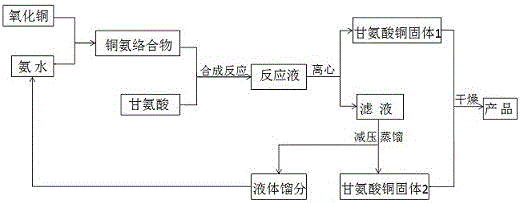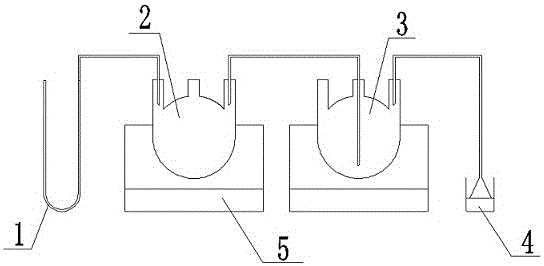Preparation method of copper glycinate
A technology of copper glycinate and glycine, which is applied in the field of preparation of copper glycinate by ammonia catalysis, can solve the problems of difficult purification and long reaction time, and achieve the effects of accelerating the sedimentation speed, increasing the yield, and reducing the discharge of waste liquid
- Summary
- Abstract
- Description
- Claims
- Application Information
AI Technical Summary
Problems solved by technology
Method used
Image
Examples
preparation example Construction
[0028] The preparation method of copper glycinate in the present invention is described in further detail below, comprises the following steps:
[0029] ① Copper oxide dissolution: According to the reaction molar ratio of copper oxide and ammonia in the ratio of 1:2 to 1:10, copper oxide is dissolved in ammonia water with a mass fraction of 5% to 50% to form a copper ammonium complex;
[0030] CuO+4NH 3 ·H 2 O→Cu(NH 3 ) 4 (OH) 2 +3H 2 o
[0031] ②Synthesis reaction: put glycine and copper ammonium complex into the reaction according to the reaction molar ratio of 1:1~3:1, the heating temperature is 30~100°C, and the reaction is 30~200min to obtain the reaction solution;
[0032]
[0033] ③Product purification: Cool the above reaction solution to 20-50°C, centrifuge to obtain copper glycinate solid 1 and filtrate, then distill the filtrate under reduced pressure to obtain copper glycinate solid 2 and liquid fraction, the pressure of vacuum distillation is -0.08MPa, Th...
Embodiment 1
[0038] Such as figure 2 As shown, add 8g of copper oxide and 100ml of ammonia water with a mass fraction of 15% to the reaction bottle 2, dissolve completely after stirring for 40min, then add 15g of glycine and then heat slowly, at the same time, add 70ml of water and 8g of oxidation Copper, stirred with a magnetic stirrer 5 at room temperature. Along with the rising of reaction temperature, the ammonia gas that slowly produces in reaction bottle 2 and reacts with glycine, simultaneously; The ammonia gas that overflows from reaction bottle 2 enters in ammonia gas recovery bottle 3 and forms copper ammonium complex with copper oxide compound, and the residual ammonia is absorbed by the tail gas treatment device 4. By observing the liquid level difference of the U-tube differential pressure gauge 1 to judge the pressure in the system, the reaction temperature can be adjusted to control the generation rate of ammonia gas. After reacting for 90 minutes, the reaction temperatur...
Embodiment 2
[0040]Add 16g of copper oxide to the ammonia gas recovery bottle 3 in Example 1, slowly add 125ml of ammonia water with a mass fraction of 25% as a new round of reaction bottle 2, fully stir for 50min, and add 45g of glycine after the copper oxide is completely dissolved Afterwards slowly heat, simultaneously, all join the liquid fraction that obtains in the vacuum distillation in embodiment 1 in the clean ammonia recovery bottle 3 and add deionized water to 210ml, add 24g cupric oxide simultaneously, stir under normal temperature, in order to Absorb the ammonia gas produced in the reaction bottle 2, and judge the pressure in the system by observing the liquid level difference of the U-tube differential pressure gauge 1, and adjust the reaction temperature to control the generation rate of ammonia gas. After 120 minutes of reaction, the reaction temperature rose to 95°C, and there was basically no gas in the reaction bottle 2, so the reaction was stopped, and the reaction solut...
PUM
 Login to View More
Login to View More Abstract
Description
Claims
Application Information
 Login to View More
Login to View More - R&D
- Intellectual Property
- Life Sciences
- Materials
- Tech Scout
- Unparalleled Data Quality
- Higher Quality Content
- 60% Fewer Hallucinations
Browse by: Latest US Patents, China's latest patents, Technical Efficacy Thesaurus, Application Domain, Technology Topic, Popular Technical Reports.
© 2025 PatSnap. All rights reserved.Legal|Privacy policy|Modern Slavery Act Transparency Statement|Sitemap|About US| Contact US: help@patsnap.com



